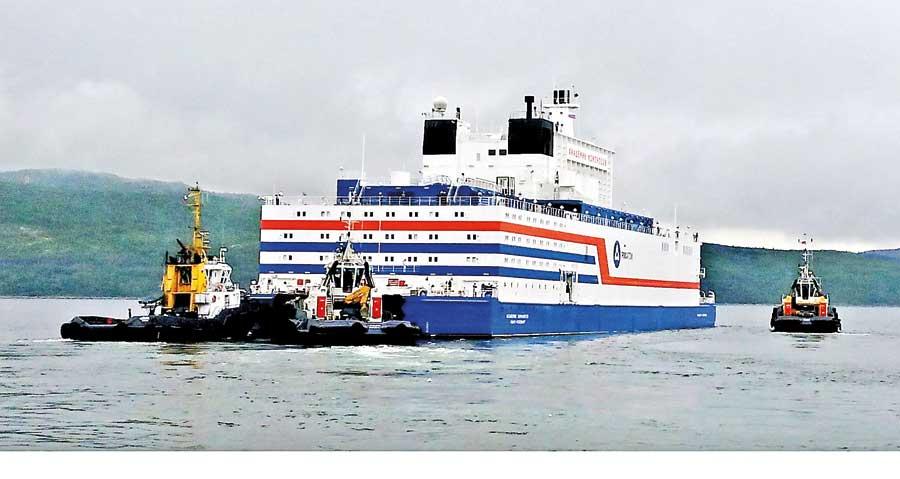Reply To:
Name - Reply Comment
Benefits outweigh drawbacks and external finance will not be a problem

A Russian floating nuclear power plant
Having taken a firm decision to include nuclear energy in its mix of energy sources, Sri Lanka is now well on the way to harnessing it. Literature on the subject shows that the benefits of going for nuclear energy outweigh the drawbacks, and external finance will not be a problem.
way to harnessing it. Literature on the subject shows that the benefits of going for nuclear energy outweigh the drawbacks, and external finance will not be a problem.
The Sri Lanka Atomic Energy Board (SLAEB) Chairman Prof. Rexy Denzil Rosa has said that Sri Lanka has identified nuclear energy as a clean and green energy source to fulfil future electricity demand. In March 2024, the Sri Lankan Cabinet committed the country to a nuclear power programme.
The International Atomic Energy Agency (IAEA) says that Sri Lanka is pursuing nuclear power to increase its low carbon power production, tackle climate change and increase energy security.
Safety Main Criterion
A team from the IAEA did a review of potential sites for a nuclear power plant from the safety perspective, from May 30 to June 5. The Site and External Events Design Review Service (SEED) mission of the IAEA reviewed Sri Lanka’s adherence to IAEA guidelines on site selection, including exclusion and screening criteria.
The SEED mission was carried out at the request of the Government and hosted by the SLAEB under the purview of the Ministry of Power and Energy. The team comprised three experts from Canada, Pakistan and Turkiye, and an IAEA staff member. The survey also involved scientists from the Geological Survey and Mines Bureau (GSMB), Central Environmental Authority (CEA) and the Department of Geology of the University of Peradeniya.
According to the IAEA, Sri Lanka has identified six “candidate sites” from three regions, including Pulmoddai in the Eastern Province which is known for its mineral sands. In the next phase, which is ongoing, IAEA will evaluate, compare and rank the “candidate” sites. The final SEED mission report will be delivered to the Government within three months.
Need for Nuclear Power
In 2022, President Ranil Wickremesinghe exhorted Sri Lankans to “seriously think about nuclear power” to overcome power shortages. SLAEB Chairman Prof. Rosa had said that Russia, US, Denmark and China had offered help to set up a Small Modular Reactor (SMR) that would cost about USD 2 billion.
India too had offered such help. In 2015, Prime Minister Narendra Modi and the then Sri Lankan President Maithripala Sirisena jointly resolved to “facilitate cooperation in the transfer and exchange of knowledge and expertise, sharing of resources, capacity building and training of personnel in peaceful uses of nuclear energy.”
The two leaders also resolved to facilitate enhanced cooperation in the areas of radioactive waste management, disaster mitigation, and environmental protection. It was reported that, in the long-term, India might be able to sell small-scale nuclear reactors to Sri Lanka which plans to produce 6,000 MW nuclear power by 2031.
The Small Medium Reactor (SMR), which produces around 100 Mw is believed to be “inherently safe” and with “minimal risk,” SLAEB Chairman, Prof. Rosa, was quoted as saying. He expected the Sri Lankan plant to be offshore barge-based. He also said that Russia had agreed to take back the nuclear waste, which, he added, was the reason for considering the proposal.
Advantages
Justifying the decision to go nuclear, Prof. Rosa said that solar and wind are good but are “intermittent, unstable, and seasonal.” If Sri Lanka is to give up coal by 2030, as planned, it has to go nuclear, he reasoned. Other justifications cited were a lower running cost, the necessity to refuel only every two or three years, and the ability to supply electricity to consumers at a lower price.
According to a report from the U.S. Office of Nuclear Energy, nuclear power plants require less maintenance and are designed to operate for longer stretches before refuelling (typically every 1.5 or 2 years).
Safety Concerns
The safety of nuclear power generation and its economic advantages were discussed in detail in a 2018 paper by Mahesh N. Jayakody and Jeysingam Jeyasugiththan of Colombo University and Prasad Mahakumara of the Government of Sri Lanka. Their study noted that while the installation cost of nuclear plants would be high, nuclear plants are marked by low maintenance costs and a minimum adverse environmental impact.
On safety, which is a major concern in Sri Lanka, the authors maintained that the evolution of nuclear power plant technologies had made reactors very safe and protected from human error. And in the long run, nuclear energy would work out to be cheaper, the authors said, and recommended the Russian VVER-1000 and the American AP-1000 models based on Pressurised Water Technology (PWR).
According to Physics World, nuclear power is ‘hundreds of times’ safer than coal, gas and oil. On the danger from nuclear waste, the website www.world-nuclear.org says: “The amount of waste generated by nuclear power is very small relative to other thermal electricity generation technologies; nuclear waste is neither particularly hazardous nor hard to manage relative to other toxic industrial waste.” A US Office of Nuclear Energy (USONE) report of 2021 said nuclear plants have the highest ‘capacity factor’ (maximum capacity) compared to any other energy source.
“Nuclear plants are producing maximum power more than 92% of the time during the year. That’s about nearly two times more than natural gas and coal units, and are almost three times or more reliable than wind and solar plants,” it said.
Russia’s Pre-eminence
Russia dominates the world market in nuclear material. Kristyna Foltynova of Radio Free Europe says that European nations are unable to stop the import of Russian nuclear material even amid the war in Ukraine.
“The same goes for uranium enrichment, the next step in the nuclear cycle. According to 2018 data, Russia once again was responsible for the largest share about 46%,” the Radio Free Europe researcher said.
“According to the latest available data, the European Union purchased about 20% of its natural uranium and 26% of its enrichment services from Russia in 2020. The US imported about 14% of its uranium and 28% of all enrichment services from Russia in 2021,” Foltynova stated.
Russia is considered the world leader in the export of nuclear plants. According to Foltynova, between 2012 and 2021, the Russian nuclear company, Rosatom, initiated the construction of 19 nuclear reactors. Fifteen of these were abroad.
The Russian TVEL Fuel Company is presently the only authorised supplier of fuel needed for VVER-440s, Foltynova points out. Russia is also able to supply High-Assay Low-Enriched Uranium (HALEU), which is a type of fuel that will be needed for more advanced reactors that are now under development by many companies in the US.
According to Bloomberg, Russia’s nuclear fuel and technology sales abroad rose more than 20% in 2022, quoting data compiled by the UK’s Royal United Services Institute.
Russian Package Deal
One of the reasons many countries want to cooperate with Russia (even defying US sanctions) is that it offers a ‘package solution’.
“Russia will not only build a nuclear plant and supply fuel, but it also trains local specialists, helps with safety questions, runs scholarship programmes and disposes of radioactive waste,” Foltynova points out. Sri Lanka has been offered such assistance according to SLAEB Chairman Prof. Rosa.
Russia also offers attractive loans, which are backed by government subsidies and cover at least 80 per cent of construction costs. “Russia has already lent USD 10 billion to Hungary, USD 11 billion to Bangladesh and USD 25 billion to Egypt to build nuclear power plants,” Foltynova says.
Russia has also signed MOUs with at least 30 countries, mostly in Africa.